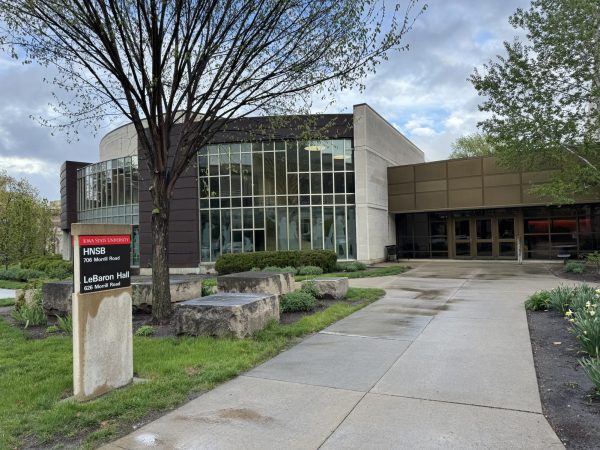ISU student adapts to Asperger’s as way of life

Dylan Voyda fiddles with his Kohl’s pocket watch, looking out on the ISU campus. Throughout his scholastic career, he has never blamed Asperger’s syndrome for any learning difficulties. Photo: Karuna Ang/Iowa State Daily
April 7, 2010
Editor’s Note: This is the second in a three-part series about an ISU student living life with Asperger’s syndrome and his transition into college. In part one, we met Dylan Voyda. In part two, we meet his syndrome and we meet his dreams in part three.
“If tomorrow someone came up with a cure for autism, I’d be scared for that cure,” said Dylan Voyda, freshman in food science diagnosed with Asperger’s syndrome when in second grade. “Normal for me is having Asperger’s, so the idea of someone taking that away from me would be the equivalent of having my leg amputated. A part of me would be completely destroyed, but if you could remove the social awkwardness but leave everything else, I’d do it.”
After discussing how open he is now, he wishes he could’ve been this open at other times in his life.
When Dylan was in 10th grade speech class, a class required by state law of Illinois, he couldn’t be honest with himself or his teacher about what was happening to him. While Dylan plowed through his speeches, his teacher would often ask him about working on all of the awkward spaces he would leave in his speeches.
“I just felt, well, I don’t feel like I have these awkward gaps, and apparently I am putting these awkward gaps in my speech and don’t notice them. That was a real problem for me.”
Dylan said he never uses his autism as a crutch. He considers himself perfectly normal, except that he has trouble in social situations. If he can do something alone, he’ll do it. If he really needs to ask for help, he’ll ask.
“The biggest struggle with Dylan’s disorder was the decision to hold him back,” said Karen Voyda, Dylan’s mother. “I always thought, you know, ‘Would we scar him? Would this make his life difficult with his peers or alienate him?’”
Dylan was held back in third grade. He agrees with the decision his mother had to make. He says he just wasn’t ready; he was never a student that needed extra help and attributes his mediocre grades to his terrible laziness.
“At the time, it was the hardest decision I’ve ever had to make. Everyone told me don’t do it,” Karen said.
As soon as Dylan’s parents were told by his guidance counselor that he might have autism, they did all the research they could muster. They did most of it online and by reading books, but only so much information was available at the time — they learned mostly from trial and error.
After doing rigorous tests until Dylan entered the fourth grade, they began to experiment with various medications for his autism that could also attend to his ADHD.
First, the Voydas put Dylan on Ritalin. While on Ritalin, Dylan would sometimes begin to crash and cry once in a while — leaving the classroom multiple times a day just to take the medication. He didn’t like to leave the classroom because his classmates would know he was different, and he wanted to be as normal as he could.
After finding that a switch to Adderall didn’t do the trick either, the Voydas finally found refuge in a medication called Concerta, a fairly newly introduced drug that Dylan still takes today.
Founded in 1965 by Bernard Rimland and Ruth Sullivan, the Autism Society of America is the universally trusted source of autism information and education. More than 13 million individuals and their families live with autism today, including 1.5 million in the United States, according to Carin Yavorcik, media specialist for the ASA. In 2009, the American Cancer Society estimated that close to 1.5 million people would be diagnosed with different types of cancer that year, and the U.S. claims that by the end of 2006, about 1.2 million Americans were living with the AIDS virus.
About 60 individuals are diagnosed with autism on a daily basis. Autism is the “fastest-growing developmental disability” and occurs in 1 in 110 births, 1 in 70 of those being boys, according to the ASA. With the growing prevalence of autism, the ASA is doing everything it can to ensure those affected are cared for in some way.
Yavorcik said that in terms of looking to the future, one of the biggest things the society is worried about is adult services. With a tidal wave of students with autism who are about to age out of schools, the system just is not prepared to address needs.
“With the appropriate services and supports, individuals with autism can lead fulfilling and productive lives, but right now when the school bus stops coming, that support system isn’t there and it’s something we’re trying to address,” said Yavorcik. “Every person with autism should be able to work and live as independently as they choose.”
Dylan never thought he had autism. He said he never thought he had anything. His father would “force autism research stuff” on him for a few years, and bring it up in casual conversation.
“’You have Asperger’s; you have autism,’ he would say to me,” Dylan said. “I remember when he said it — I felt nothing, because that’s when I finally realized that it’s always been a part of me.”
Gary and Karen Voyda never viewed Dylan’s disorder as a handicap, and tried to keep him in the regular schools and mainstream him as much as possible.
“Dylan has trouble holding still and can’t stop talking. He’s overly extroverted and doesn’t know how to read people sometimes,” Gary said.
Despite his inability to read social cues and his other symptoms, Dylan’s parents wouldn’t treat him any differently than their other son, Jeremy. Punishing their two sons the same, the Voydas didn’t baby Dylan, but certainly never told him he couldn’t do something.
After they discovered Dylan wasn’t athletic, they encouraged him to use his musical ability to his fullest potential.
“Music helped Dylan find a way to express himself,” Karen said. “Before that, he felt more alienated from his friends and classmates. Singing made him feel like he had a strength.”
He began singing jazz and continued all throughout his high school career, where he was the only senior male to make his vocal jazz choir group.
“You know how some people say that they have a perfect life,” Dylan said. “Well, I have a perfect life.”
During his teenage years, Dylan separated himself from others partly because of his disorder, and because he just didn’t feel like he connected with anyone.
He began to rebel like most teenagers, except in a different way: he rebelled against kids his own age, and worshiped his parents, as well as having conversations with his teachers.
With somewhat of a dissonance with his generation, Dylan also finds it hard to connect with his younger brother, Jeremy, a sophomore in high school.
Dylan got back to working on a puzzle he had started earlier. He paused for a very long time and switched topics.
“I can’t take a hint. I had to learn when to stop talking,” he said. “Non-verbal communication is not, is not, just doesn’t come to you. You actually fail to understand what it means and why something like eye contact is important.”
Another significant symptom of Asperger’s is that those who have it have no comfort zones. Dylan went to a speech therapist to learn about personal space because he had never really experienced anything like it.
He got up from the couch and stood right next to my chair, almost uncomfortably close. He asked me if I’m uncomfortable yet.
“Sort of,” I said.
“Yeah, see, I’m not,” he said.
Autism Statistics
- 1 percent of the population of children in the U.S. ages 3-17 have an autism spectrum disorder.
- Prevalence is estimated at 1 in 110 births.
- 1 to 1.5 million Americans live with an autism spectrum disorder.
- Fastest-growing developmental disability; 1,148 percent growth rate.
- 10-17 percent annual growth.
- $60 billion annual cost.
- 60 percent of costs are in adult services.
- Cost of lifelong care can be reduced by two-thirds with early diagnosis and intervention.
- In 10 years, the annual cost will be $200-400 billion.
- 1 percent of the adult population of the United Kingdom have an autism spectrum disorder.
- The cost of autism over the lifespan is $3.2 million per person.
- 1.5 million Americans today are believed to have some form of autism.
— From the Autism Society of America
Facts about Asperger’s
- One in five of the disorders included in the list of Pervasive Developmental Disorders, autism is a neurological disorder that slows development in both verbal and social skills.
- In 1994, Asperger’s Disorder became a separate disorder from autism when it was included in the American Psychiatric Association’s Diagnostic and Statistical Manual of Mental Disorders.
- Many specialists dealing with Asperger’s Disorder still believe that it should be included with autism.
— From the Autism Society of America
















